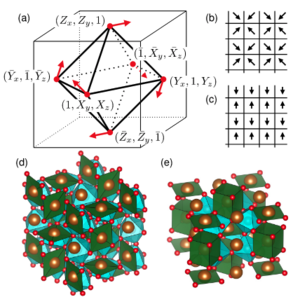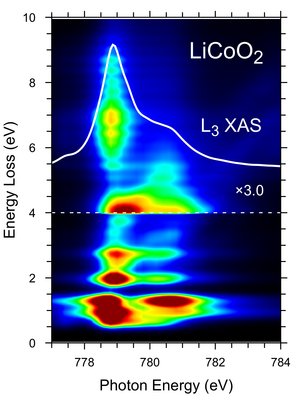Valence skipping, internal doping, and site-selective Mott transition in PbCoO3 under pressure
PbCoO3 is a material which combines a number phenomena found in transition-metal oxides: site-selective Mott transition, spin-state crossover, valence skipping and internal doping -- valence change of Co due to transfer of electrons from Pb. In addition these phenomena are closeluy coupled to structural modifications -- tilting of the oxygen octahedra. We present a comprehesive theoretical study, which shows how these phenomena arise from correlation effects on the Co-site and the location of Pb-O antibondning states in the vicinity of Fermi level.
Valence skipping, internal doping, and site-selective Mott transition in PbCoO3 under pressure
LDA + DMFT approach to resonant inelastic x-ray scattering in correlated materials (copy 1)
We present a computational study of resonant inelastic x-ray scattering (RIXS) at the L edges of selected 3d transition-metal oxides using a combination of the density-functional theory and the dynamical mean-field theory (DMFT). The present method, built around the Anderson impurity model with a DMFT-optimized continuum bath, can be viewed as an extension of the cluster model that allows us to include unbound electron-hole pair excitations and to substantially reduce the number of empirical parameters. We find a good agreement with available experimental data and discuss the relationship between the electronic structure and fluorescencelike features in the RIXS spectra.
LDA + DMFT approach to resonant inelastic x-ray scattering in correlated materials![]() Phys. Rev. B 101, 115130 (2020) (Editor’s Suggestion)
Phys. Rev. B 101, 115130 (2020) (Editor’s Suggestion)
Spin-polarized antiferromagnet RuO2
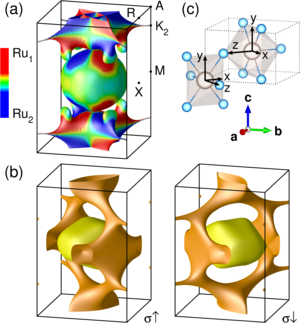
(a) Fermi surface of paramagnetic RuO2obtainedwith HF method. The color codes the atomic polarization(difference of the Ru1 and Ru2 contributions to the wave-function at a given k-point). (b) Spin-polarized Fermi surfaceof the AFM state. (c) Crystal structure of RuO2with global,a,b,c, and local coordinates indicated.
RuO2 is member of rather small family of metallic antiferromagnets. Even more is the fact that the AFM order does not break the translation, but a rotation symmetry. The magnetic sublattices being connected by 90deg rotation results in a spin-polarized band structure and Fermi surface. We thus predict a longintudinal spin conductivity that change sign between (110) and (1-10) directions.
Antiferromagnetism in RuO2 as d-wave Poneranchuk instability![]() Phys. Rev. B 99, 184432 (2019)
Phys. Rev. B 99, 184432 (2019)
Collective modes with DMFT
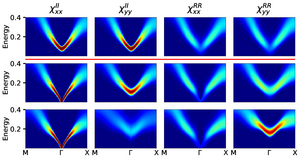
We use DMFT linear response formalism to study behavior of collective modes when continuous symmetry is spontaneously broken at second order phase transition. We observe appearance of Goldstone modes as predicted by general theory. We also investigate situations when a symmetry is weakly broken in the Hamiltonian (e.g. by single-ion anisotropy in magnetic system) and observe a cross-over between gapped Goldstone (phase) mode and Higgs (amplitude) mode as a function of the Weiss-field amplitude.
Collective Modes in Excitonic Magnets: Dynamical Mean-Field Study
![]() Phys. Rev. Lett. 122, 127601 (2019)
Phys. Rev. Lett. 122, 127601 (2019)
LDA+DMFT to RIXS analysis in correlated materials
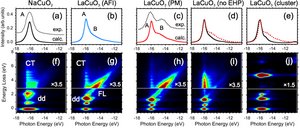
The calculated L3-edge XAS and RIXS spectra for (a),(f) NaCuO2 and LaCuO3 in the (b),(g) AFI phase, (c),(h) PM phase, (d), (i) no electron-hole pair, and (e),(j) CuO6 cluster model.
We developed a computational method for analyzing modern resonant inelastic x-ray scattering (RIXS) in correlated materials, such as 3d transition-metal oxides. The method builds on the combination of local density approximation (LDA) and dynamical mean-field theory (DMFT), and describe fine RIXS features originating from both localized (e.g. multiplet excitations) and delocalized excitations (e.g. charge-transfer, unbound electron-hole pair excitations) in the crystal. We have provided the microscopic explanation for the emergent mechanism of fluorescence features across L-edge spectra in high-valence cuprates.
Continuum Charge Excitations in High-Valence Transition-Metal Oxides Revealed by Resonant Inelastic X-Ray Scattering ![]() Phys. Rev. Lett. 121, 126403 (2018)
Phys. Rev. Lett. 121, 126403 (2018)
Excitonic dispersion in LaCoO3 revealed by RIXS
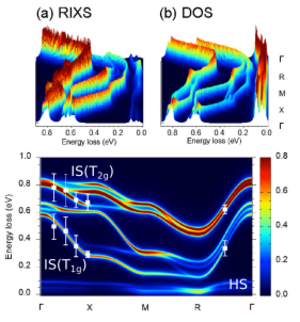
Using Co L3-edge resonant inelastic X-ray scattering (RIXS) we have observed a clear dispersion of the IS excitations in LaCoO3 at 20K. The experimental data agree well with the theoretical analysis based on the density-functional theory followed by the strong-coupling expansion and calculation of the RIXS intensities. Our observations point to an important role of IS excitations for the low-energy physics of the material.
Excitonic dispersion of the intermediate-spin state in LaCoO3 revealed by resonant inelastic X-ray scattering ![]() Phys. Rev. B 98, 035149 (2018)
Phys. Rev. B 98, 035149 (2018)
Exciton condensation in LaCoO3?
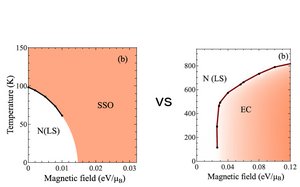
A meta-magnetic transition in fields above 50 T has been observed recently in low temperature regime of LaCoO3. We have considered two possible scenarios of field induced transitions: a) spin-state ordering, b) excitonic condensation, and used a simplified two-orbital model. While both (a) and (b) can be induced by an external field, the temperature derivatives of the critical field in the two scenarios have opposite signs. It turns our that the experimental dBc /dT is consistent with the excitonic scenario. Based on this observation we propose a new conceptual picture of LaCoO3, in which the excited multiplets (in particular the intermediate spin states) cannot be viewed as associated with a given atom, but rather as atomic size mobile excitons.
Field-induced exciton condensation in LaCoO3
![]() Sci. Rep 6, 30510 (2016)
Sci. Rep 6, 30510 (2016)
Spontaneous spin textures
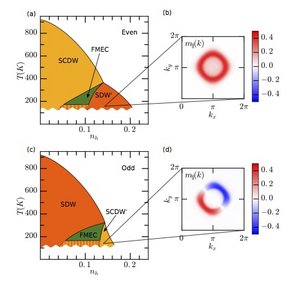
Excitonic condesates in strongly correlated electron systems can take a variety of theormodynamic phases depending on the detailed of the microscopic interactions. Studying the two-band Hubbard model at 2-x filling we have obtained a state with a spin texture in reciprocal space (while there is no spin polarization in the direct space). Such a spin texture can be viewed as a macroscopic spin current arising due to (spontaneous) dynamically generated spin-orbit coupling. The possibility of spin-galvanic effect in such a state is subject of further research.
Spontaneous Spin Textures in Multiorbital Mott Systems
![]() Phys. Rev. Lett. 116, 256403 (2016)
Phys. Rev. Lett. 116, 256403 (2016)


